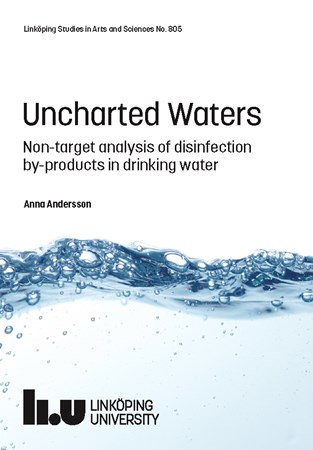Chlorination is used to prevent the spread of disease through drinking water and to maintain water quality in the distribution network. Swedish waterworks put much effort into ensuring that the quality of the water is high, but the chlorination procedure used presents a dilemma: it may lead to the formation of disinfection by-products. At the moment, we don’t know in detail which by-products the population is exposed to, or how they affect health. This is why researchers and waterworks operators are working together to ensure that the tap water is as pure as possible.
In her thesis, Anna Andersson has investigated a relatively little-known group of disinfection by-products. The substances she has looked at contain chlorine and bromine, but consist of larger molecules than the by-products that are currently regulated in Sweden. She has studied the extent to which these disinfection by-products can be harmful to health and how they reach the taps that supply our drinking water. She has also identified in which waterworks they are found, and examined how new purification processes can reduce the amounts formed . The work has been carried out in collaboration with operators of Swedish waterworks, using new methods developed for the specific purpose of measuring these by-products.
“The thesis provides new knowledge about disinfection by-products, which will enable waterworks to improve monitoring and initiatives to reduce health risks”, says Anna Andersson, who recently presented her doctoral thesis at the Department of Thematic Studies, Linköping University.
What comes out of the tap?
One discovery presented is that the disinfection by-products undergo changes on their journey from the waterworks, through the distribution network and into the kitchen tap. This means that what the consumer is exposed to is not the same as is measured at the waterworks.Anna Andersson and her colleagues used what is known as a non-target approach to observe the changes that occur in the water on its way to consumers. In this case, the researchers screened for by-products rather than looking for already known substances, and could in this way obtain information about the composition of the by-products. The number of large disinfection by-products falls and their composition changes as the water travels to the consumers’ taps. The ratio between chlorine and bromine by-products changes, which is an important result, since by-products with bromine are more harmful to health.
The effects of treatment technique
The thesis also examines how new treatment techniques can reduce the amounts of by-products formed. One new technique that the researchers showed has high potential is known as suspended ion exchange. The examination also showed that molecules that absorb ultraviolet light are associated with the formation of harmful substances, and it is thus important to remove these during the treatment procedure. The various treatment methods were evaluated using both chemical analysis and analysis of toxicity. The method enabled the researchers to see the associations between the composition of the by-products and how toxic the mixture became.
The collaboration between Anna Andersson (together with other researchers in the field) and the waterworks – and the new knowledge it has produced – have led to some waterworks testing new methods.
“As the treatment processes are updated, some waterworks are testing whether to phase out the use of chlorine. It will be exciting to see how it goes”, says Anna Andersson.
The thesis is a compilation thesis that consists of four articles.
The thesis:
Uncharted Waters: Non-target analysis of disinfection by-products in drinking water. Anna Andersson (2021). Linköping University, Department of Thematic Studies – Environmental Change. Linköping University, Faculty of Arts and Sciences

